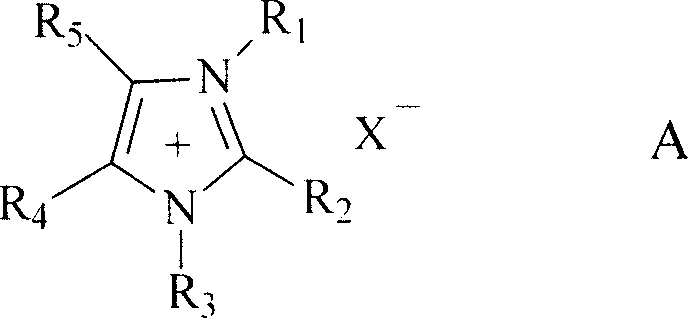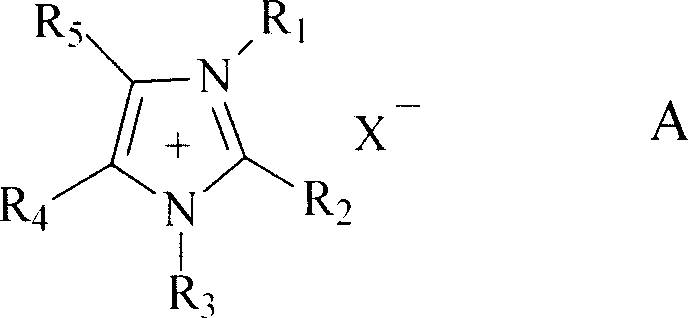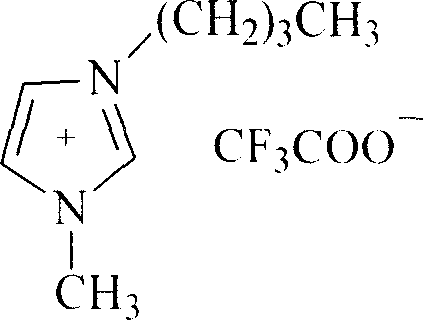Wet spinning method for polyacryl-nitrile fibre
A polyacrylonitrile fiber, wet spinning technology, applied in the direction of wet spinning, fiber chemical characteristics, single-component synthetic polymer rayon, etc., can solve the extremely high corrosion resistance requirements of production equipment, strong sodium thiocyanate Corrosiveness, production environment air pollution and other issues, to achieve the effect of environmental protection, strong solubility, wide adjustable range
- Summary
- Abstract
- Description
- Claims
- Application Information
AI Technical Summary
Problems solved by technology
Method used
Image
Examples
Embodiment 1
[0021] The polyacrylonitrile resin is uniformly mixed with the ionic liquid to form a slurry, and the content of the polyacrylonitrile resin in the slurry is 12 wt%. Swell at a temperature of 18°C for 45 minutes, then heat up to 95°C and dissolve for 2.5 hours to form a uniform solution to make a spinning dope. The spinning stock solution is spun after filtering and defoaming, and the temperature of the stock solution is 115°C. The coagulation bath is an aqueous solution of ionic liquid, wherein the content of the ionic liquid is 24wt%, and the temperature of the coagulation bath is 45°C.
[0022] The ionic liquid adopted has the following structural formula:
[0023]
[0024] The spinning speed is 8m / min, and the coagulated and formed fibers are processed by subsequent processes such as washing, stretching, drying and setting, crimping and cutting to obtain polyacrylonitrile staple fibers with a specification of 2.2dtex×50mm. The measured breaking strength was 3.4 cN / d...
Embodiment 2
[0026] The polyacrylonitrile resin was uniformly mixed with the ionic liquid to form a slurry, and the content of the polyacrylonitrile resin in the slurry was 11 wt%. Swell at a temperature of 16°C for 65 minutes, then raise the temperature to 55°C and dissolve for 3.5 hours to form a uniform solution to make a spinning dope. The spinning stock solution is spun after filtering and defoaming, and the temperature of the stock solution is 110°C. The coagulation bath is an aqueous solution of ionic liquid, wherein the content of the ionic liquid is 25 wt%, and the temperature of the coagulation bath is 38°C.
[0027] The ionic liquid adopted has the following structural formula:
[0028]
[0029] The spinning speed is 7m / min, and the coagulated and formed fibers are processed by washing, stretching, drying and setting, crimping and cutting to obtain short polyacrylonitrile fibers with a specification of 3.6dtex×65mm. The measured breaking strength was 2.5 cN / dtex and the bre...
Embodiment 3
[0031] The polyacrylonitrile resin is uniformly mixed with the ionic liquid to form a slurry, and the content of the polyacrylonitrile resin in the slurry is 30 wt%. Swell at a temperature of 40°C for 35 minutes, then raise the temperature to 110°C and dissolve for 3 hours to form a uniform solution to make a spinning dope. The spinning stock solution is spun after filtering and defoaming, and the temperature of the stock solution is 120°C. The coagulation bath is an aqueous solution of ionic liquid, wherein the content of the ionic liquid is 35 wt%, and the temperature of the coagulation bath is 60°C.
[0032] The ionic liquid adopted has the following structural formula:
[0033]
[0034] The spinning speed is 8m / min, and the coagulated fibers are washed, stretched, dried and shaped, crimped and cut to obtain short polyacrylonitrile fibers with a specification of 3.2dtex×65mm. The measured breaking strength was 2.9 cN / dtex and the breaking elongation was 35%.
PUM
| Property | Measurement | Unit |
|---|---|---|
| elongation at break | aaaaa | aaaaa |
| elongation at break | aaaaa | aaaaa |
| elongation at break | aaaaa | aaaaa |
Abstract
Description
Claims
Application Information
 Login to View More
Login to View More - R&D
- Intellectual Property
- Life Sciences
- Materials
- Tech Scout
- Unparalleled Data Quality
- Higher Quality Content
- 60% Fewer Hallucinations
Browse by: Latest US Patents, China's latest patents, Technical Efficacy Thesaurus, Application Domain, Technology Topic, Popular Technical Reports.
© 2025 PatSnap. All rights reserved.Legal|Privacy policy|Modern Slavery Act Transparency Statement|Sitemap|About US| Contact US: help@patsnap.com



